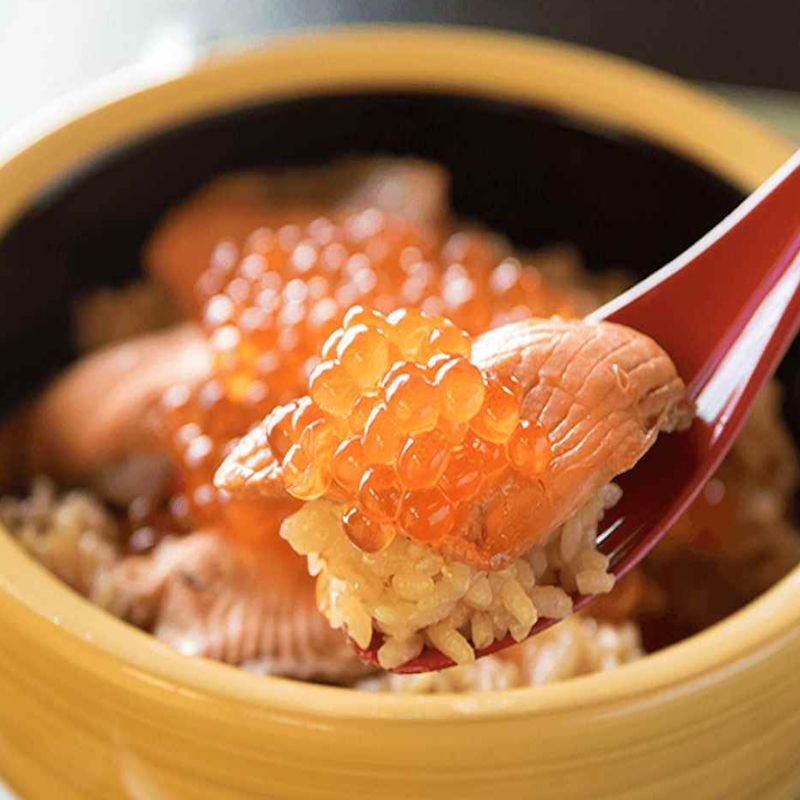Harako Meshi (ハラコ飯) Salmon Roe Rice
 Garanties sécurité
Garanties sécurité
(à modifier dans le module "Réassurance")
 Politique de livraison
Politique de livraison
(à modifier dans le module "Réassurance")
 Politique retours
Politique retours
(à modifier dans le module "Réassurance")
History
Harako Meshi is a traditional Japanese dish, particularly popular in the Tohoku region. This rice dish, garnished with salmon and salmon roe (ikura), is a famous railway bento in the Sendai and Morioka stations, as well as in other places in Tohoku. The basic concept is to top rice with salmon and roe, creating a simple yet delicious dish.
The salmon is filleted, with the skin and bones removed, and the flesh is thinly sliced. The slices of salmon are lightly simmered in a broth of sake, soy sauce, mirin, and sugar, then set aside. The roe is gently separated and quickly passed through the same broth used for the salmon before being set aside.
The rice is cooked in this enriched simmering broth. Harako meshi refers to the rice cooked and seasoned, garnished with salmon and roe. "Harako" is the local term for salmon roe (ikura), and "meshi" means rice.
The Abukama River, known for its salmon run, flows from Fukushima to Miyagi and empties into the Pacific Ocean. Harako meshi was served in autumn to the feudal lord Date Masamune when he came to inspect the construction of the Teizan Canal. This dish was an offering made to Masamune by the fishermen of the Watari Arahama region.
White rice is a valuable source of nutrition. The simmered broth gains umami after blanching the salmon and roe. Cooking the rice in this umami-filled broth and serving it with salmon and roe makes this dish a lavish specialty in regions abundant with salmon.
Harako Meshi Recipe:
Ingredients:
- 2 cups of rice (300g) Tsuyahime or Koshihikari
(Tsuyahime rice carries genes of this legendary rice, much like the Koshihikari variety, considered the king of Japanese rice. The grains of Tsuyahime are notably uniform and visually satisfying.) - 2 fresh salmon fillets
- 1/2 cup sake
- 2 tablespoons soy sauce
- 2 tablespoons pure rice mirin
- 1/2 teaspoon salt
- 1/2 cup salmon roe (ikura)
- 1 teaspoon dashi base
- 1 piece of kombu (seaweed) (about 5 cm, optional)
- Chives or shiso (perilla leaf) for garnish (optional)
Preparation:
- Wash the rice.
If using kombu, add it to the rice. Let it soak in water for about 30 minutes before cooking. - Cut the salmon into bite-sized pieces and remove the bones.
Cooking the salmon:
While the rice is soaking, in a pot, combine the sake, soy sauce, mirin, and salt. Bring to a boil over medium heat. Add the cut salmon and let it simmer gently.
Once the salmon becomes tender and changes from orange to light pink, turn off the heat. Remove the salmon and kombu and set them aside. - Gently shred the salmon using two forks.
- Place the rice in a rice cooker and pour in the broth used to cook the salmon. Add water if necessary.
Assembly:
- Add the shredded salmon to the rice and gently mix to avoid mashing the grains.
- Generously garnish with salmon roe (ikura). Serve in bowls and top with chives or shiso for a finishing touch.
Japanese Rice Legend
It’s essential to understand that the history of rice in Japanese society is almost legendary. In ancient times, long before writing, rice was perceived as a "gift from the gods." According to myths and stories from Japanese tradition, rice came from the world of the gods. A god, living in a heavenly realm above ours with his child, was central to these tales.
The name of this child, Hō no Ninigi no Mikoto, is symbolic: "Hō" means "rice ears" and "Ninigi" translates to "living," expressing that "rice grows abundantly thanks to divine blessing." Hō no Ninigi no Mikoto’s grandmother was none other than the sun goddess, Amaterasu no Ōmikami (天照大神). When he descended to earth, Amaterasu no Ōmikami offered him rice, entrusting him with the mission to spread it across the world.
Thus, in the collective imagination of the time, rice was seen as a sacred treasure, a precious gift from the goddess Amaterasu no Ōmikami. This mythic origin underscores the profound importance and value that rice holds in Japanese culture.
Japanese Rice Varieties Offered by Hill Cottage:
-
Haenuki Rice はえぬき
Haenuki Japanese rice is of high quality, ideal for making sushi, maki, risottos, and rice pudding. The bright, white, and soft grains of Tsuyahime rice are perfect for both savory and sweet preparations. Known for its unparalleled softness and elasticity, it is awarded the best rating by the Japan Grain Inspection Association: Toku A. -
Hitomebore Rice ひとめぼれ
Hitomebore means "love at first sight" in Japanese. This rice is named for its exceptional balance, which makes everyone fall in love with the first bite. It is soft and well-balanced in flavor, highly regarded by the Japanese.
Use: Sushi, rice bowls, excellent flavor when eaten cold. -
Koshihikari Rice: The King of Japanese Rice コシヒカリ
Koshihikari rice, often called "the king of rice" in Japan, is renowned for its exceptional qualities. It stands out for its brilliant sheen, slightly sticky texture, and rich umami flavor. Koshihikari is a short-grain japonica rice, one of the most sought-after and famous varieties in Japan, known for its luminous appearance or "hikari."
This variety makes up about a third of Japan’s total rice production. Three regions are particularly famous for their superior Koshihikari: Uonuma in Niigata Prefecture on Honshu, Sado in Niigata Prefecture on Sado Island, and Iwafune in Niigata Prefecture. These areas produce rice of exceptional quality, a true gem of Japanese cuisine.


